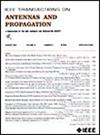Investigation of Broadband Scattering Properties of PEC/Dielectric Composite Objects Using Adaptive Integral Methods and Asymptotic Waveform Evaluation
IF 5.8
1区 计算机科学
Q1 ENGINEERING, ELECTRICAL & ELECTRONIC
引用次数: 0
Abstract
In this communication, we propose a novel technique based on the electric field integral equation (EFIE)-coupled Poggio-Miller–Chang-Harrington–Wu-Tsai (PMCHWT) equation to effectively analyze the broadband properties of dielectric/metallic composite objects. In the conventional asymptotic waveform evaluation (AWE) technique, the Padé approximation solution obtained by Taylor series fitting is used to achieve a fast frequency sweep. In addition to computing and storing the high-order frequency derivatives of the impedance matrix, the moments of the linear system have to be solved iteratively. In this communication, the pseudospectral derivative method (PSDM) is used to derive the high-order impedance matrix at the center point from the zero-order impedance matrix at the AWE sampling point based on Gauss-Lobatto–Chebyshev (GLC) interpolation. Furthermore, the adaptive integral method (AIM) is used to solve integral equations and reduce the storage of zero-order impedance matrices. It also speeds up all matrix-vector multiplications in linear matrix systems and iterative solvers. The results of the three numerical examples show that the proposed method achieves higher computational efficiency by avoiding full frequency sweeps while maintaining accuracy in computing wideband scattering responses.基于自适应积分法和渐近波形评估的PEC/介电复合物体宽带散射特性研究
在本文中,我们提出了一种基于电场积分方程(EFIE)耦合Poggio-Miller-Chang-Harrington-Wu-Tsai (PMCHWT)方程的新技术来有效地分析介电/金属复合物体的宽带特性。在传统的渐近波形评估(AWE)技术中,采用Taylor级数拟合得到的pad近似解来实现快速扫频。除了计算和存储阻抗矩阵的高阶频率导数外,线性系统的矩必须迭代求解。在该通信中,基于gaas - lobatto - chebyshev (GLC)插值,采用伪谱导数法(PSDM)从AWE采样点的零阶阻抗矩阵推导出中心点的高阶阻抗矩阵。此外,采用自适应积分法求解积分方程,减少零阶阻抗矩阵的存储。它还加速了线性矩阵系统和迭代求解器中的所有矩阵-向量乘法。三个数值算例的结果表明,该方法在保持宽带散射响应计算精度的同时,避免了全频率扫频,提高了计算效率。
本文章由计算机程序翻译,如有差异,请以英文原文为准。
求助全文
约1分钟内获得全文
求助全文
来源期刊
CiteScore
10.40
自引率
28.10%
发文量
968
审稿时长
4.7 months
期刊介绍:
IEEE Transactions on Antennas and Propagation includes theoretical and experimental advances in antennas, including design and development, and in the propagation of electromagnetic waves, including scattering, diffraction, and interaction with continuous media; and applications pertaining to antennas and propagation, such as remote sensing, applied optics, and millimeter and submillimeter wave techniques

 求助内容:
求助内容: 应助结果提醒方式:
应助结果提醒方式:


